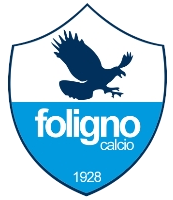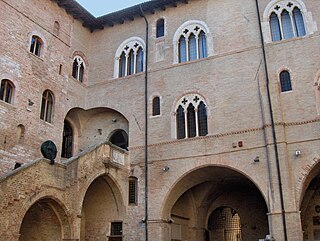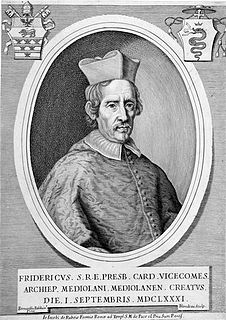
Foligno is an ancient town of Italy in the province of Perugia in east central Umbria, on the Topino river where it leaves the Apennines and enters the wide plain of the Clitunno river system. It is located 40 kilometres south-east of Perugia, 10 km (6 mi) north-north-west of Trevi and 6 km (4 mi) south of Spello.

A.S.D. Città di Foligno 1928 S.r.l. is an Italian association football club, based in Foligno, Umbria. It currently plays in Serie D.
Federico Giunti is an Italian former footballer turned manager, who played as a midfielder in the role of deep-lying playmaker. He is the current manager of Milan Primavera.
The Premio Parioli is a Group 3 flat horse race in Italy open to three-year-old thoroughbred colts. It is run over a distance of 1,600 metres at Capannelle in April.

Saint Felician(us) of Foligno is the patron saint of Foligno.

Saint Bonfilius was an Italian saint.
Giovanni Antonio Serbelloni was an Italian Cardinal.

The Italian Catholic diocese of Todi existed until 1986, when it was united into the diocese of Orvieto-Todi. Up until that point, the diocese had always been directly dependent on the Holy See.

The Diocese of Tivoli is a Roman Catholic ecclesiastical territory in Latium, Italy, which has existed since the 2nd century. In 2002 territory was added to it from the Territorial Abbey of Subiaco. The diocese is immediately subject to the Holy See.

The Italian Catholic Diocese of Foligno is in Umbria. It is a suffragan of the Archdiocese of Perugia-Città della Pieve.

The Trinci Palace is a patrician residence in the center of Foligno, central Italy. It houses an archaeological museum, the city's picture gallery, a multimedia museum of Tournaments and Jousts and the Civic Museum.

Foligno Cathedral is a Roman Catholic cathedral situated on the Piazza della Repubblica in the center of Foligno, Italy. The cathedral, built on the site of an earlier basilica, is dedicated to the patron saint of the city, the martyr Felician of Foligno, who was buried here in 251 AD. It is the seat of the Bishop of Foligno.
Giovanni Benedetti was an Italian prelate of Roman Catholic Church. He was Bishop of Foligno for more than 26 years.

Foligno railway station serves the town and comune of Foligno, in the region of Umbria, central Italy. It is also the most important railway junction in Umbria. Opened in 1866, it forms part of the Ancona–Orte railway, and is the southeastern terminus of the Foligno–Terontola railway, which links Florence with Rome.

Federico Visconti (1617–1693) was an Italian Cardinal and Archbishop of Milan from 1681 to 1693.

Marina Sereni is an Italian politician. She was the Vice President of the Italian Democratic Party and has been Vice President of the Chamber of Deputies from 2013 to 2018.
Tommaso Orsini was a Roman Catholic prelate who served as Bishop of Foligno (1568–1576) and Bishop of Strongoli (1566–1568).
Francesco Simonetta was a Roman Catholic prelate who served as Bishop of Foligno (1606–1612) and Apostolic Nuncio to Poland (1606–1612).
Porfirio Feliciani was a Roman Catholic prelate who served as Bishop of Foligno (1612–1634).

Frederick Mason Perkins was an American art historian, critic, and collector.












